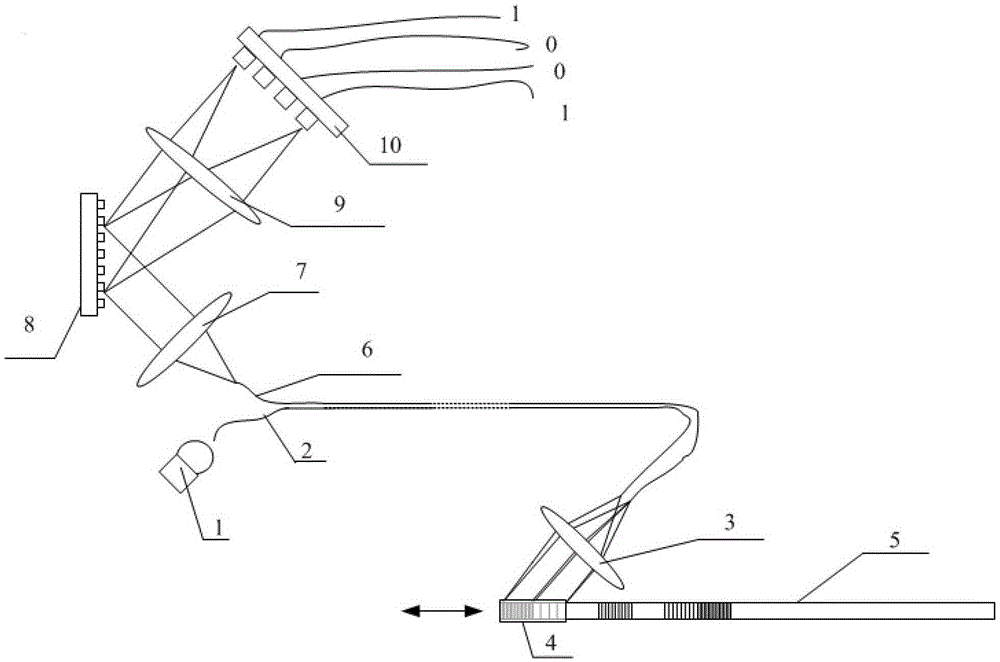A Digital Wavelength Coded Optical Absolute Displacement Sensor
An absolute displacement sensor technology, applied in the field of displacement sensor, to simplify the demodulation system and improve the response frequency
- Summary
- Abstract
- Description
- Claims
- Application Information
AI Technical Summary
Problems solved by technology
Method used
Image
Examples
Embodiment 1
[0055] Taking the four-digit coded grating ruler as an example, the size of the grating unit is 100μm×1.5mm (1.5mm along the direction of the grating line), and the width of the grating ruler is 1.5mm. For the structure of the grating ruler, see Image 6 As shown, the relationship between the code combination and displacement of the demodulation system is shown in Table 1.
[0056] The size of the aperture is 0.3mm×2mm, the four sets of gratings of the grating scale are 1200lines / mm(n4), 1071lines / mm(n3), 968lines / mm(n2), 882lines / mm(n1), the four sets of gratings are Collimated diffraction wavelengths are: 500nm, 560nm, 620nm and 680nm. The light source is a halogen tungsten light source with a bandwidth of 400-1000nm. It is transmitted through the optical fiber 2 and then collimated by the collimator lens 3. After passing through the diaphragm 4, it is incident on the grating scale 5 with an incident angle of 17.46°. The diffracted light passes through the light again. Stop...
Embodiment 2
[0060] Take the "three-point" four-digit coded grating scale as an example. The grating scale is divided into three areas. The grating unit size of each area is 300μm×2mm, and the width of the grating scale is 6mm. The width of the grating ruler is 2mm, and the aperture is also divided into three areas. The structure of the grating ruler is shown in Figure 7 shown. The coding misalignment between the grating units in the three areas is 100 μm, that is, Figure 7 Shown: Codes appear at 0.1mm, 0.2mm, and 0.3mm respectively on the gratings of C area, B area, and A area. The relationship between the code combination and the displacement of the demodulation system is shown in Table 2.
[0061] Table 2
[0062]
[0063]
[0064] The aperture size is 0.9mm×7mm, divided into three areas, such as Figure 7 The three areas A, B, and C are shown. The size of A area and C area is 0.9mm×2.5mm, and the size of B area is 0.9mm×2mm. The diaphragm partitions strictly correspond to t...
Embodiment 3
[0066] The width of the grating ruler is 8mm, and it is divided into 4 areas. The size of the grating unit in each area is 200μm×2mm (2mm along the direction of the grating line). The grating units in the 4 areas are dislocated, and the dislocation amount is 50μm. The grating ruler contains a total of four groups of different grating line densities, which are 1250lines / mm, 1091lines / mm, 967.7lines / mm, and 870lines / mm. The blaze angle of the grating is 17.5°, and the incident light includes a combined light source of four groups of light sources with center wavelengths of 480, 550, 620, and 690nm and full width at half maximum greater than 10nm. The incoming part of the light source is guided by a 400μm optical fiber, and the receiving part uses 4 optical fibers corresponding to the 4 areas of the grating scale. After the incident light passes through the transmission fiber, it becomes parallel light through the collimating lens (focal length: 9mm, aperture: 6mm), and an apertu...
PUM
 Login to View More
Login to View More Abstract
Description
Claims
Application Information
 Login to View More
Login to View More - R&D
- Intellectual Property
- Life Sciences
- Materials
- Tech Scout
- Unparalleled Data Quality
- Higher Quality Content
- 60% Fewer Hallucinations
Browse by: Latest US Patents, China's latest patents, Technical Efficacy Thesaurus, Application Domain, Technology Topic, Popular Technical Reports.
© 2025 PatSnap. All rights reserved.Legal|Privacy policy|Modern Slavery Act Transparency Statement|Sitemap|About US| Contact US: help@patsnap.com



